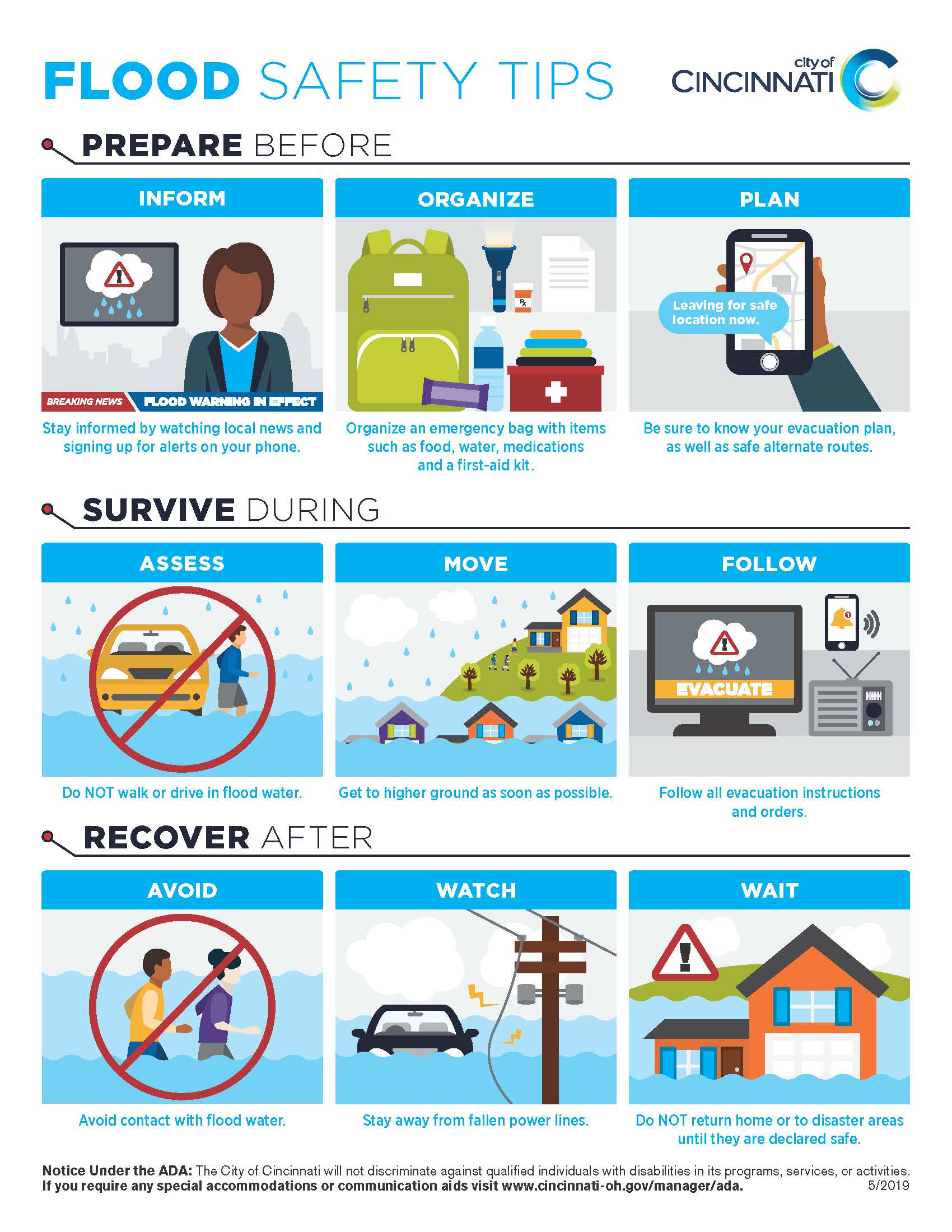Flood Safety
- Most homeowners insurance does NOT cover flood damage
- Residents of the city of Cincinnati are eligible to purchase flood insurance from the National Flood Insurance Program
- It takes 30 days after purchase for a policy to take effect, so it’s important to buy insurance before the floodwaters start to rise
- Your home has a 26% chance of being damaged by a flood during the course of a 30-year mortgage, compared to a 9% chance of fire
- Just an inch of water can cause costly damage to your property
- A car can easily be carried away by just two feet of floodwater
- Winter storms and snowmelt are common (but often overlooked) causes of flooding
- Federal disaster assistance is usually a loan that must be paid back with interest

What to do BEFORE a flood:
Prepare Your House
- Make sure your sump pump is working
- Clear debris from gutters and downspouts
- Anchor any fuel tanks
- An unanchored tank in your basement can be torn free by floodwaters and the broken supply line can contaminate your basement
- An unanchored tank outside can be swept downstream, where it can damage other houses
- Have a licensed electrician raise electric components (switches, sockets, circuit breakers and wiring) at least 12” above your home’s projected flood elevation
- Place the furnace and water heater on masonry blocks or concrete at least 12” above the projected flood elevation
- Keep an inventory of all valuables. Include their age and value. If possible, keep the original purchase receipts for verification.
Safeguard Your Possessions
- Make sure any photos or videos of all your important possessions are in a safe place. These documents will help you file a full flood insurance claim.
- Store important documents and irreplaceable personal objects (such as photographs) where they won’t get damaged
- If major flooding is expected, move furniture and valuables to the upper levels of your home and move your vehicles to high ground
Develop a Family Emergency Plan
- Post emergency telephone numbers by the phone. Teach children to dial 911.
- Plan and practice a flood evacuation route with your family
- Ask an out-of-city or state relative or friend to be the “family contact” in case your family is separated during a flood. Make sure everyone in the family knows the name, address, and phone number of this contact person.
- Have a plan for your pets.
What to do DURING a flood:
- Fill bathtubs, sinks and jugs with clean water in case water becomes contaminated
- Listen to a battery or hand-crank operated radio for the latest storm information
- If local authorities instruct you to do so, turn off all utilities at the main power switch and close the main gas valve
- If told to evacuate your home, do so immediately
- If the waters start to rise inside your house before you have evacuated, retreat to the second floor, the attic, or if necessary, the roof
- Floodwaters may carry raw sewage, chemical waste and other disease-spreading substances. If you’ve come in contact with floodwaters, wash your hands with soap and disinfected water.
- Avoid walking through floodwaters. As little as six inches of moving water can knock you off your feet.
- Electric current passes easily through water, so stay away from downed power lines and electrical wires.
- Animals lose their homes in floods, too. Be aware that even domesticated animals may be confused and unpredictable in a flood situation.
Water covered roads
Each year, more deaths occur due to flooding than from any other severe weather related hazard. The Centers for Disease Control report that over half of all flood-related drownings occur when a vehicle is driven into hazardous flood water. The next highest percentage of flood-related deaths is due to walking into or near flood waters.
The main reason is people underestimate the force and power of water. Many of the deaths occur in automobiles as they are swept downstream. Of these drownings, many are preventable, but too many people continue to drive around the barriers that warn you the road is flooded.
The reason that so many people drown during flooding is because few of them realize the incredible power of water. A mere six inches of fast-moving flood water can knock over an adult. It takes only two feet of rushing water to carry away most vehicles. This includes pickups and SUVs.
If you come to an area that is covered with water, you will not know the depth of the water or the condition of the ground under the water. This is especially true at night, when your vision is more limited. Play it smart, play it safe. Whether driving or walking, any time you come to a flooded road,
Remember: Turn Around, Don't Drown!
Storm Drain Inlets

Teach your children to never play in or near storm pipes, inlets, creeks and ditches. Sudden heavy rainfall can send torrents of fast-moving water into these structures. The suction and force that is sometimes created could be extremely dangerous to anyone caught in the powerful current.
If you observe a pipe or inlet that is clogged with debris, please do NOT attempt to clear the obstruction yourself, especially during rain. The sudden suction caused by the release of the clog could cause you to be swept into the intake in the strong current. Call (513) 591-5050 any time for assistance, or email StormwaterManagement@cincinnati-oh.gov to report any clogged, damaged, or contaminated storm water inlets.
Please do not use storm pipes and inlets to dispose of garbage, yard wastes, or anything that could block the entrance of storm water. It is very important to keep these pipes open and clear so they can do what they were designed to do – protect you and your property.

What to do AFTER a flood:
- If your home has suffered damage, call the agent who handles your flood insurance to file a claim. If you are unable to stay in your home, let the agent know where you can be reached.
- Check for structural damage before reentering your home. You want to make sure your home is safe.
- Take photos of any water in the house and save damaged personal property.
- This will make filing a claim easier
- If necessary, place these items outside the home
- An insurance adjuster will need to see what has been damaged in order to process your claim
- Make a list of damaged or lost items and include their age and value where possible
- Prevent mold by removing wet contents immediately
- Wet carpeting, furniture, bedding, and any other items holding moisture or water inside the building can develop mold within 24 to 48 hours
- Items should be cleaned with a phenolic or pine-oil cleaner and bleach solution, completely dried, and monitored for several days for any fungal growth or odors
- If any mold develops, throw the items away
- Do not use matches, cigarette lighters or other open flames upon reentering your property
- Gas may be trapped inside
- If you smell gas or hear a hissing, open a window, leave quickly and call the gas company from a neighbor’s home
- Keep power off until an electrician has inspected your system for safety
- Avoid using toilets and the tap until you have checked for sewage and water line damage. If you suspect damage, call a plumber.
- Throw away any food including canned goods that have come in contact with floodwaters
- Boil water for drinking and food preparation until local authorities declare your water supply to be safe
- Salvage water-damaged books, heirlooms, and photographs using proper restoration techniques (http://www.archives.gov/preservation/disaster-response/guidelines.html)
- Follow local building codes and ordinances when rebuilding. Use flood resistant materials and techniques to protect your property from future flood damage.
- For more information, visit https://www.fema.gov/flood-insurance

Flooding is a coast-to-coast threat to some part of the United States and its territories nearly every day of the year. This site is designed to teach you how to stay safe in a flood event. https://www.weather.gov/safety/flood

The City of Cincinnati Fire Department’s emergency preparedness resources.
https://www.cincinnati-oh.gov/fire/

Web site providing useful information on how to prepare for a flood.
BE PREPARED FOR A FLOOD
